[et_pb_section bb_built=”1″][et_pb_row][et_pb_column type=”4_4″][et_pb_text _builder_version=”3.0.82″ background_layout=”light” text_line_height=”1.4em” border_style=”solid” box_shadow_position=”outer”]
This blog post is by Amanda White, a MA student in English at the University of Arkansas currently completing a rare books internship in the University of Arkansas Libraries’ Special Collections.
The Special Collections Reading Room in Mullins Library is currently housing a new exhibit that features several different facsimiles, or reproductions, of William Blake’s engraved, poetic works. While many are familiar with poems such as “The Tyger,” “The Shepherd,” and The Marriage of Heaven and Hell, his artistic work is far less known. Blake spent nearly 40 years of his life producing these “illuminated books.” They represent many different aspects of the legacy he left behind. They showcase the poetic genius that has made him a focus of both study and renown long after his death. They also exhibit his equally important artistic contribution and Blake was uniquely in control of these poetic works.
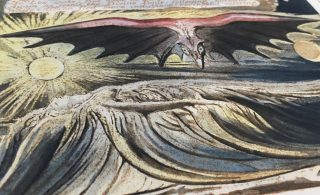
In 1788, when Blake first began producing his illuminated poems, developed his own artistic medium: relief etching. He began with a piece of engraved copper that he etched himself. By applying various inks and watercolors by hand, using small brushes and pens to write his text backwards, Blake could produce these elaborate images that were tailored to his individual poems. Because his engraving style allowed him to reuse the engraved plates, and to apply new inks and paints if he so desired, Blake could continuously reproduce new and unique works. While various forms of engravings were being applied to poems at the time, Blake’s original method gave him unique control over the text. His relief etching allowed him to fill every role of the creation process: that of poet, painter, and printer. Never before had a poet united the various stages of book production in this manner; and applying the tools of drawing, engraving, and painting freed Blake to think in new ways and unite invention and execution in methods that conventional printmaking had never made possible.
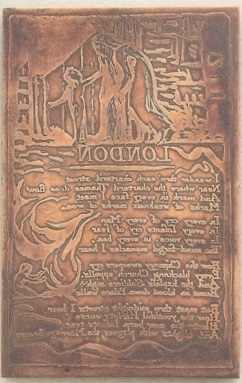
The current Blake exhibit features many of his most popular illuminated books, including the Songs of Innocence, Jerusalem, The Book of Urizen, and the Book of Ahania. Each text represents the various engraving methods that Blake utilized throughout his career to depict his poetic masterpieces. The Songs of Innocence, shown in facsimile form, was produced by Blake between the years 1790-1794 and is one of the earliest and most popular of Blake’s illuminated books. The digital reproduction housed in the Special Collections department comes to us from the Trianon Press, who have produced some of the most detailed facsimiles that are available to scholars. Consisting of 31 plates total, this illuminated text showcases simpler water-color washes. The coloring for these works became far more elaborate after 1794. These short, lyrical poems at first read, and look, like an illustrated children’s book; but the underlying themes speak to and question many aspects of adulthood that Blake was concerned with.
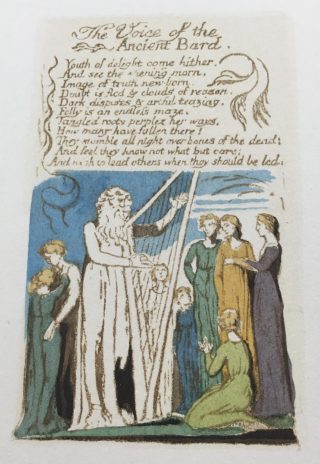
Of all his illuminated books, Jerusalem is considered Blake’s greatest work. Only five copies are known to have been produced by Blake. The facsimile featured in this exhibit is reproduced from the fifth copy. Jerusalem showcases many of the qualities that set Blake apart from both traditional poets and artists. The images found throughout the poem are done in Blake’s iconic “relief etching.” The unique nature of this etching method allows him to manipulate his text in several ways. An example of this can be seen in Jerusalem. Once the original engraving was made, different paints could be applied to it at any time to achieve a vastly different illumination. An early edition might feature images colored with blues and greens. A later one might have images engraved with pinks and oranges. In addition to allowing Blake to remake his illuminations with relative ease, scholars are also able to pinpoint exactly when a specific copy was printed, and from what original edition it comes from. Jerusalem represents many of the issues found throughout Blake’s poetic works, the mental conflicts he faced, and the spiritual ordeals he underwent throughout his life.
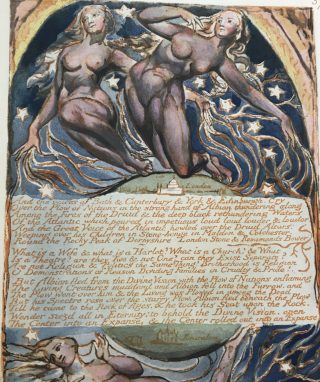
The unique color-printing method Blake employed for his illuminated book were rendered in opaque pigments that he crafted himself. As a result of both the engraving method and ink choices, it is very difficult to produce satisfactory facsimiles, as is the case with the Book of Urizen. Only the seventh and final copy of this poem, printed in 1815, was suitable for reproduction. This edition features plates outlined with orange-brown ink. The images themselves are done in saturated water-colors and even gold on many of the plates. A “complete” copy of The Book of Urizen holds 28 plates. As is the case with many of his illuminated books, the number and arrangement of plates can vary; our edition contains 27 plates. This particular facsimile represents the highest quality put forth by the Trianon Press. Of all reproductions made, this one is bested suited for instructional and research use.
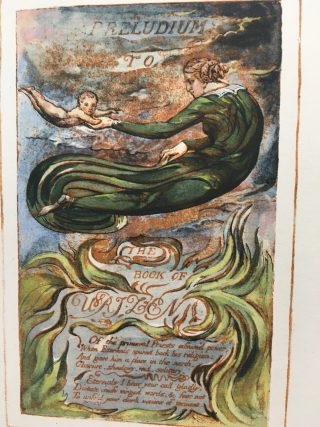
While Blake’s relief etching is one of the iconic characteristics of his illuminated works that set him apart from other poets and artists, it was a laborious and expensive endeavor. The Book of Ahania represents one of the final illuminated poems produced by Blake. Deviating from his usual “relief etching,” this smaller work was printed in a more conventional way, by using intaglio plates, and is dated 1795. Blake only ever completed one copy of this text, never included it in his list of productions, and did not dispense it to a customer or patron, as far as we know. It wasn’t until 1855 that the Book of Ahania emerged again, after being purchased at a Sotheby auction. Based on the themes found in this text, scholars have generally agreed that Ahania continues and concludes the creation myth that Blake began in the Book of Urizen.
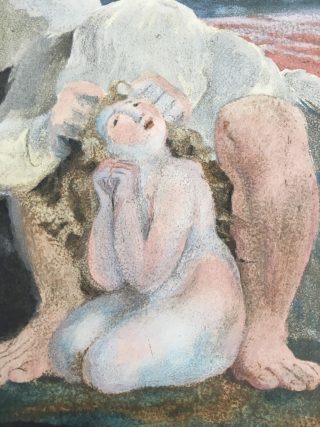

It is difficult to study Blake’s illuminated books up close and personal. The most accessible way to view these poems in facsimile form. His relief etching method presents a rare challenge to properly reproduce poems such as Jerusalem and the Book of Urizen. As a result, many facsimiles are not suitable for teaching or research. Fortunately, the various facsimiles in Special Collections are reproduced from the Rosenwald Collection, located in the Library of Congress. They represent some of the finest facsimiles ever produced, crafted by the Trianon Press; and they are ideal for anyone who wishes to study Blake and his illuminated works. Students who are interested in Blake’s poetry and teachers who wish to teach an overlooked aspect of Blake and his poetry can find easy access to the facsimiles in Special Collections.
[/et_pb_text][/et_pb_column][/et_pb_row][/et_pb_section]
